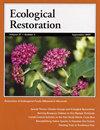Are Pre-Restoration Soil Seed Banks and Vegetation Nested and Predictive Subsets of Post-Restoration Communities?
IF 1.1
4区 环境科学与生态学
Q2 ECOLOGY
引用次数: 1
Abstract
ABSTRACT Ecological restoration projects could benefit from using knowledge of pre-restoration conditions to forecast potential restoration outcomes, including species compositional change that can be among the most stochastic changes in ecosystems. In Pinus ponderosa (ponderosa pine) forests in Arizona, USA, predictability of understory plant composition from pre-restoration soil seed banks, on-site vegetation, and nearby vegetation was examined for 12 years after restorative forest thinning treatments. Pre-restoration seed banks and vegetation were nested and predictive subsets of post-restoration species composition of understory communities. For example, the portion of species in the pre-restoration seed bank also in the on-site vegetation increased from 32% before to 79% five years after restoration at nine sites. As many as 57–69% of species only inhabiting seed banks before restoration transitioned to occurring in vegetation, strengthening seed bank:vegetation correspondence. In total, knowledge of pre-restoration seed bank and vegetation composition enabled forecasting 64–76% of the species in vegetation up to 12 years after restoration, with another 14–26% of species predictable from species composition in nearby remnant openings. Ecosystems in which practitioners may anticipate predictability of species compositional changes after restoration could include habitats with high potential for seed bank:vegetation synchrony (i.e. seed banks containing species capable of growing in a site’s vegetation), moderately shaded structure enabling species varying in shade tolerance to coexist, and with seed dispersal (at least stochastic long-distance dispersal) subordinate to local regeneration from seed banks and vegetative expansion. Changes in species composition may be more deterministic than stochastic in at least some ecosystems undergoing restoration.恢复前的土壤种子库和植被是恢复后群落的嵌套和预测子集吗?
生态恢复项目可以利用恢复前条件的知识来预测潜在的恢复结果,包括生态系统中最随机的物种组成变化。在美国亚利桑那州的黄松(ponderosa)森林中,研究了恢复前土壤种子库、现场植被和附近植被对森林间伐后12年林下植物组成的可预测性。恢复前的种子库和植被是恢复后林下群落物种组成的嵌套和预测子集。例如,恢复前种子库中的物种在现场植被中的比例从恢复前的32%增加到恢复后5年的79%。多达57-69%的物种在恢复前仅栖息于种子库中,并在植被中发生,加强了种子库与植被的对应关系。总体而言,通过对恢复前种子库和植被组成的了解,可以预测恢复后12年内64-76%的植被物种,另外14-26%的物种可以通过附近残洞的物种组成预测。在生态系统中,从业者可以预测恢复后物种组成变化的可预测性,包括具有高种子库潜力的栖息地:植被同步性(即包含能够在场地植被中生长的物种的种子库),适度遮荫的结构使不同的物种能够共存,种子传播(至少是随机的长距离传播)服从于种子库的局部更新和植被扩张。至少在某些正在恢复的生态系统中,物种组成的变化可能更具确定性而非随机性。
本文章由计算机程序翻译,如有差异,请以英文原文为准。
求助全文
约1分钟内获得全文
求助全文
来源期刊

Ecological Restoration
Environmental Science-Nature and Landscape Conservation
CiteScore
1.70
自引率
12.50%
发文量
24
期刊介绍:
Ecological Restoration is a forum for people advancing the science and practice of restoration ecology. It features the technical and biological aspects of restoring landscapes, as well as collaborations between restorationists and the design professions, land-use policy, the role of education, and more. This quarterly publication includes peer-reviewed science articles, perspectives and notes, book reviews, abstracts of restoration ecology progress published elsewhere, and announcements of scientific and professional meetings.
 求助内容:
求助内容: 应助结果提醒方式:
应助结果提醒方式:


